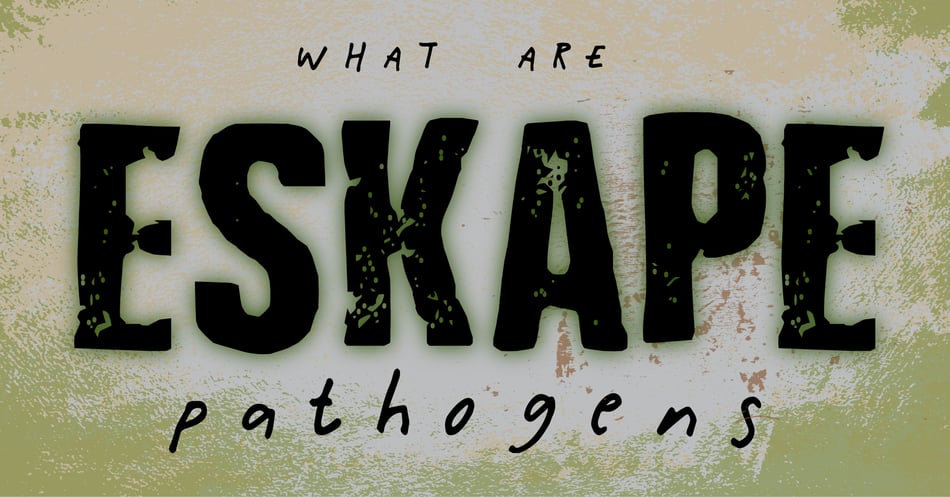What Are ESKAPE Pathogens?

In 2008, the medical field presented data to the federal government in support of funding to study antimicrobial resistance in hospital-associated pathogens. A leading figure in the effort, Dr. Louis B. Rice, had spent his career studying the mechanisms of antibiotic resistance and knew first-hand the threat presented by resistant pathogens as hospital-acquired infections. In his statement of support to continued funding of research, Dr. Rice coined a term that has become a useful acronym for anyone working in the field of infection prevention and control: ESKAPE pathogens. In today's post, we will discover these pathogens and the status of our fight against them since Dr. Rice first devised the term.
Bacteria surround us. Bacteria is present on all the surfaces we touch, in the air we breathe, and even inside our bodies. Usually, we enjoy a peaceful truce with bacteria: Thanks to our natural defenses (skin, immune system), we don't have to engage in any protracted battles with bacteria. They get what they need from us, and we even get some help from them. However, this truce is betrayed the moment our defenses become weak or come down altogether, that is, when we get a cut, catch a virus, or require medical care in a hospital.
In a hospital, pathogens not only have access to vulnerable patients with wounds, indwelling devices, and weakened immune systems, they get numerous opportunities to become resistant to antibiotics. This is because of selective antibiotic pressure: The antibiotic applies the pressure, which kills the bacteria without the resistance, thereby selecting those with the resistance to survive. Those pathogens that survive a dose of antibiotics due to a mutation pass that mutation on to future generations. A bacteria outside a hospital does not have this exposure to antibiotics, so any resistant mutations don't have any special selective pressure and therefore do not become dominant.
Not all pathogens in hospitals are resistant - most will still respond to at least one if not more types of antibiotics. However, a small group of pathogens have both evolved to resist many types of antibiotics and are prevalent in hospitals around the world. These pathogens are now collectively known as ESKAPE pathogens - those that can escape antibiotics - thanks to Dr. Rice's helpful acronym.
E: Enterococcus faecium | Affects immunocompromised patients
Resistant to beta-lactam antibiotics (like penicillin) and last-resort antibiotics; includes VRE
S: Staphylococcus aureus | Affects patients with wounds or indwelling devices
Resistant to Methicillin (MRSA), beta-lactam antibiotics; also releases exotoxins
K: Klebsiella pneumoniae | Affects patients with respiratory illness and ventilators
Resistant to beta-lactam antibiotics, some to carbapenem; creates thick biofilms
A: Acinetobacter baumanni | Affects immunocompromised patients
Resistant to all known antibiotics; can survive in extreme environments
P: Pseudomonas aeruginosa | Affects patients with advanced lung disease
Resistant to all known antibiotics as well as many detergents
E: Enterobacer species | Affects patients with catheters and central lines
Resistant to many antibiotics as well as many detergents
The funding Dr. Rice and colleagues were supporting in 2008 contributed to the (slowly) growing awareness of the threat of antibiotic resistance in the United States. Efforts to increase pharmaceutical options have increased, as have renewed efforts to discover the biological mechanisms of the resistance. Despite all these efforts, cases of multi-drug resistant organisms (MDROs) have continued to grow over the past decade. Conservative estimates put the number of MDRO infections in the US in 2010 over 2 million, resulting in 23,000 deaths per year. However, recent re-evaluations of this data put the number closer to 70,000.
With drug therapies in the pipeline but years away, and growing resistance and spread, what are our options for a solution? One important solution is to find ways to prevent the pathogen from reaching the vulnerable patient. Hand hygiene, sterile technique, and judicious use of indwelling devices reduce the opportunity for ESKAPE pathogens to reach the patient. A solution that does not rely on human processes (and the inevitable errors that come as a result) are biocidal surfaces that kill the ESKAPE pathogens before they can be picked up and transmitted by healthcare worker hands, devices, objects, and the atmosphere itself. But not all so-called biocidal materials are equal to the task. Materials treated with quaternary ammonium compounds (QUATS) - whether residual or long-lasting - can actually contribute to antibiotic resistance since pathogens can become resistant to the chemicals in QUATS. In fact, the only biocidal material that does not lead to resistance is copper and copper-infused materials. Since bacteria cannot become resistant to copper (it is an essential mineral required for survival), ESKAPE pathogens have no way to avoid taking in the copper ions and dying as a result. In fact, you could say, they cannot escape the biocidal properties of copper.
![EOScu Logo - Dark - Outlined [07182023]-01](https://blog.eoscu.com/hubfs/Eoscu_June2024/Images/EOScu%20Logo%20-%20Dark%20-%20Outlined%20%5B07182023%5D-01.svg)

![[infographic] Pathogens, Prevalence and Persistence Download and share!](https://no-cache.hubspot.com/cta/default/216314/interactive-178382222670.png)



